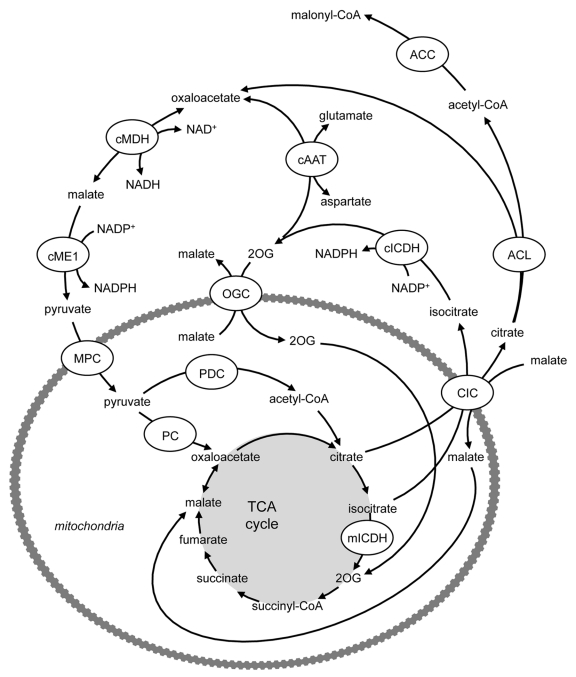Figure 4. The pyruvate/citrate and pyruvate/isocitrate pathways are initiated by the conversion of pyruvate to both oxaloacetate (via PC) and acetyl-CoA (via PDC), allowing the formation of citrate and subsequently isocitrate. Both citrate and isocitrate can be transported to the cytosol by the citrate-isocitrate carrier (CIC), where citrate can be converted to isocitrate by cytosolic aconitase. Cytosolic citrate can be cleaved by ATP-citrate lyase (ACL) to acetyl-CoA and oxaloacetate. Oxaloacetate can be converted to malate by cytosolic MDH (cMDH), also generating NADH, and then the coupling factor NADPH can be generated by conversion of malate to pyruvate by cME (as in the pyruvate/malate pathway). Pyruvate can then re-enter the mitochondria completing the cycle. Since the pyruvate/citrate cycle also forms cytosolic acetyl-CoA, it can generate malonyl-CoA. Malonyl-CoA serves both as an intermediate in FA synthesis and also a potent inhibitor of FA oxidation at the level of carnitine palmitoyltransferase (CPT) 1. Cytosolic isocitrate can directly yield NADPH by its conversion to 2OG by cICDH. Potentially, 2OG can be converted to oxaloacetate by cAAT, thereby “joining” the pyruvate/citrate cycle, generating NADPH a second time at the level of cME or alternatively, enter the mitochondria via OGC and join the TCA cycle, at the step subsequent to mICDH, and be metabolized to oxaloacetate. AAT, aspartate aminotransferase; ACC, acetyl-CoA carboxylase; ACL, ATP-citrate lyase; CIC, citrate isocitrate carrier; ICDH, isocitrate dehydrogenase; MDH, malate dehydrogenase; ME, malic enzyme; MPC, mitochondrial pyruvate carrier; PC, pyruvate carboxylase; PDC, pyruvate dehydrogenase complex; OGC, 2-oxoglutarate carrier.

An official website of the United States government
Here's how you know
Official websites use .gov
A
.gov website belongs to an official
government organization in the United States.
Secure .gov websites use HTTPS
A lock (
) or https:// means you've safely
connected to the .gov website. Share sensitive
information only on official, secure websites.
